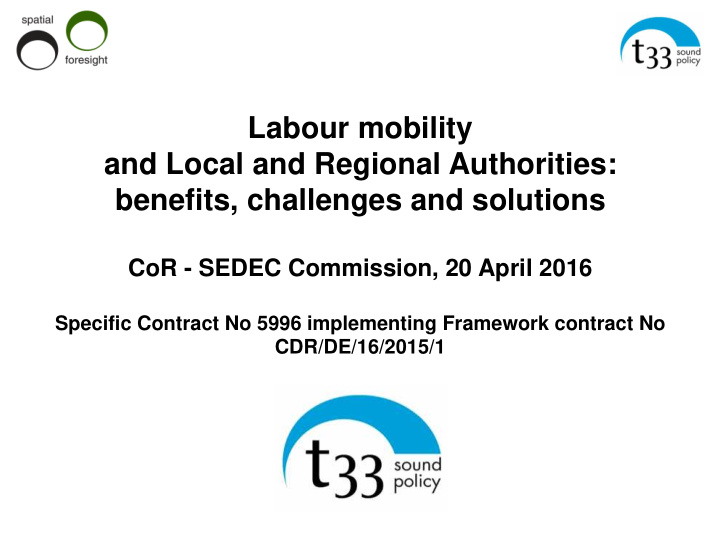



Labour mobility and Local and Regional Authorities: benefits, challenges and solutions CoR - SEDEC Commission, 20 April 2016 Specific Contract No 5996 implementing Framework contract No CDR/DE/16/2015/1
Key findings (1) Nearly 34 million migrants, 14.3 million EU migrants EU citizens acquire new citizenship primarily in Germany, the United Kingdom, Sweden, France, Belgium, Hungary and Italy Intra-EU fluxes flow from the southern and eastern EU regions towards the central and northern ones Positive net migration fluxes (including non-EU and within MSs) mainly involve urban areas EU foreign migrants primarily moved for job-related reasons 15 million people employed in the EU were foreign citizens (of which 7.2 EU) Highest number of EU foreign citizens in Germany , the United Kingdom , Spain , Italy and France (2006-2014)
Key findings (2) EU15 immigrants are more highly educated than both non-EU immigrants and the national population in every country analysed The proportion of highly qualified immigrants from the new EU MSs varies substantially across destination countries 24.5% of total first generation immigrants moved to another EU MS for a short period of time (1-5 years), while approximately half of them moved for a long time period (10 years or over) Lack of language skills seems to be the most challenging barrier
Key findings (3) 1.92 million posted workers in the EU (2014) Poland is the top sending country; Germany is the first receiving country Geographic proximity plays an important role in postings The majority of EU workers are posted in industrial sector Differentiation in terms of distribution of postings across economic sectors between EU15 MSs and EU13+EFTA 1.1 million cross-border workers (2014) Majority of cross-border workers are located in north- western Europe
Benefits Positive contribution to the skill mix and Regions of destination enhancement of competitiveness Labour shortage reduction Net contribution to the budget of the host region Mobile workers send remittances home Regions of Workers may return with more experience, origin skills and savings Increased GDP in the EU EU internal Facilitating the flows of trade, investment market and innovative ideas Better job opportunities Individual More savings if returning home workers
Challenges and risks Pressure on local services Regions of Socio- economic discrimination of mobile destination workers Outflows of young workers Regions of Brain-drain effect origin Persisting legal and administrative barriers EU internal market to the single market Lack of information about workers’ rights Increasing euroscepticism driven by anti- immigration positions Language and culture obstacles Individual Institutional and bureaucratic barriers workers
List of case studies Aim of the Typology of Case study Main benefit Main challenge initiative workers Brainport Talent Centre – Brainport Positive skill-mix Pressure on local Migrant workers region Eindhoven contribution services (NL) ASTER Talents and Knowledge - IT - Migrant workers Facilitation of the flows of ‘Brain - drain’ effect Attract Emilia-Romagna (mainly young) innovative ideas mobile Region (IT) workers Migrant workers Language and cultural MobiPro EU (DE) Labour shortage reduction (mainly young) barriers IT specialist for the Cross-border Facilitation of the flows of Pressure on local Øresund Region workers, Migrant innovative ideas services (at cross-border level) (SE+DK) workers Academic Incubators of Retain (Potential) Increased experience and Outflows of young Entrepreneurship – local Migrant Workers skills for workers workers Subcarpathian workers Region (PL)
List of case studies Aim of the Typology of Case study Main benefit Main challenge initiative workers The Global Training Migrant workers Increased experience and Language and cultural Programme - Basque (mainly young) skills for workers barriers Region (ES) Positive skill-mix ‘Brain - drain’ effect CB Talents (PT) Migrant workers contribution Cross-border Enhance EURES TransTirolia Increased experience and Legal and administrative workers, Migrant labour (AT+IT+CH) skills for workers barriers workers circulation Posted workers, Socio-economic TRANSPO Project Cross-border Better job opportunities discrimination of mobile (IT+FR+RO) workers workers Posted workers, Socio-economic DGB Fair mobility Cross-border Better job opportunities discrimination of mobile (DE+RO+BG+SI) workers workers
Key recommendations Monitor data and information on migrant workers (both sent and received; posted workers; internal, cross- border, EC level) Publish surveys at the local level to contrast negativity and growing scepticism Identify the most promising sectors and ascertain the territorial needs in terms of human capital, new talents, innovative ideas and knowledge (KIT study) Adopt supporting and informative tools – also at the cross-border or inter-regional level – for workers who are posted
Key recommendations Establish partnerships between the labour offices of the sending and receiving regions (sector oriented) More targeted information on the intra-EU labour mobility opportunities for job seekers, workers and employers (EURES; Europass; social networks) Encourage workers to experience labour mobility (summer schools; language course; job trainings) Create inter-regional business incubators and networks of entrepreneurship Develop more programmes to re-integrate and attract emigrated workers (administrative simplification for investment)
Recommend
More recommend